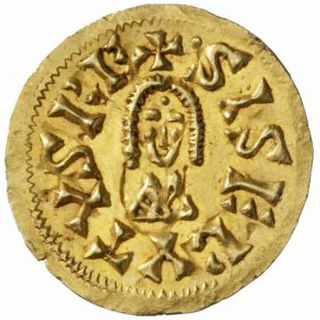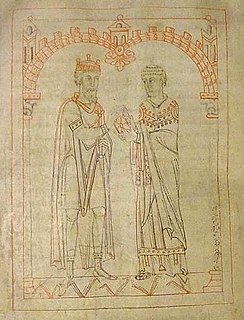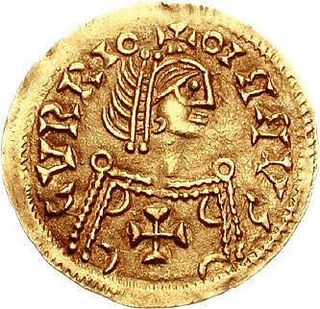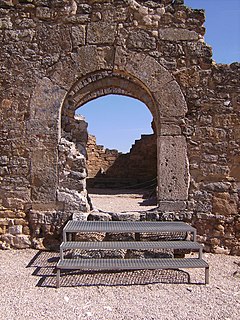Related Research Articles

The Suebi were a large group of Germanic peoples originally from the Elbe river region in what is now Germany and the Czech Republic. In the early Roman era they included many peoples with their own names such as the Marcomanni, Quadi, Hermunduri, Semnones, and Lombards. New groupings formed later such as the Alamanni and Bavarians and two kingdoms in the Migration Period were simply referred to as Suebian.

Pelagius was an Iberian Visigoth nobleman who founded the Kingdom of Asturias in 718. Pelagius is credited with initiating the Reconquista, the Christian reconquest of the Iberian Peninsula from the Moors, and establishing the Asturian monarchy, making him the forefather of all the future Iberian monarchies, including the Kings of Castile, the Kings of León, and the Kings of Portugal.

Gesalic, Gesaleico in Spanish and Portuguese, Gesaleic in Catalan,, was a king of the Visigoths from 507 to 511, and died in 513. Although the illegitimate son of Alaric II, he had been elected king by the Visigoths after Alaric had been killed in battle by the Franks. Alaric's only legitimate son, Amalaric, was a child and too young to rule.

The Astures or Asturs, also named Astyrs, were the Hispano-Celtic inhabitants of the northwest area of Hispania that now comprises almost the entire modern autonomous community of Principality of Asturias, the modern province of León, and the northern part of the modern province of Zamora, and eastern Trás os Montes in Portugal. They were a horse-riding highland cattle-raising people who lived in circular huts of stone drywall construction. The Albiones were a major tribe from western Asturias. Isidore of Seville gave an etymology as coming from a river Asturia, identified by David Magie with Órbigo river in the plain of León, by others the modern Esla river.
This is a historical timeline of the Iberian Peninsula during the period of the Germanic kingdoms.
Hermeric was the king of the Suevi from at least 419 and possibly as early as 406 until his abdication in 438.

Liuva I was a Visigothic King of Hispania and Septimania.

Witteric was the Visigoth King of Hispania, Septimania and Galicia. He ruled from 603 to 610.

Gundemar was a Visigothic King of Hispania, Septimania and Galicia (610–612).

Sisebut was King of the Visigoths and ruler of Hispania and Septimania from 612 until his death.

Rechiar or Rechiarius was the Suevic king of Gallaecia from 448 until his death. He was the first Chalcedonian Christian (Catholic) Germanic king in Europe and one of the most innovative and belligerent of the Suevi monarchs. Despite his orthodox Christianity, Hydatius, the contemporary bishop and chronicler from Galicia who is the sole contemporary source for biographical details of Rechiar, established his reputation as that of a barbarian with little sense of Roman law, culture, or custom.

The Kingdom of the Suebi, also called the Kingdom of Gallæcia or Suebi Kingdom of Gallæcia, was a Germanic post-Roman kingdom that was one of the first to separate from the Roman Empire. Based in the former Roman provinces of Gallaecia and northern Lusitania, the de facto kingdom was established by the Suebi about 409, and during the 6th century it became a formally declared kingdom identifying with Gallaecia. It maintained its independence until 585, when it was annexed by the Visigoths, and was turned into the sixth province of the Visigothic Kingdom in Hispania.

Theodemir or Theodemar was one of the last Suevic kings of Galicia and one of the first Chalcedonian Christians to hold the title. He succeeded Ariamir sometime between the end of May 561 and the year 566 and ruled until his death.

Miro was the Suebian King of Galicia from 570 until his death in 583. His reign was marked by attempts to forge alliances with other Chalcedonian Christian nations with the goal of checking the power of the Arian Visigoths under Leovigild. During his reign relations were established with both Francia and the Byzantine Empire and the kingdom reached its zenith, but it collapsed within three years of his death.

Audeca or Andeca was the last Suevic King of Galicia from 584 until his deposition in 585. He deposed Eboric and usurped the throne by marrying the young king's mother, Siseguntia, the widow of Eboric's father and predecessor, Miro. He consigned Eboric to a monastery.

The Visigothic Kingdom or the Kingdom of the Visigoths was a kingdom that occupied what is now southwestern France and the Iberian Peninsula from the 5th to the 8th centuries. One of the Germanic successor states to the Western Roman Empire, it was originally created by the settlement of the Visigoths under King Wallia in the province of Gallia Aquitania in southwest Gaul by the Roman government and then extended by conquest over all of Hispania. The Kingdom maintained independence from the Eastern Roman or Byzantine Empire, whose attempts to re-establish Roman authority in Hispania were only partially successful and short-lived.

Reccopolis, located near the tiny modern village of Zorita de los Canes in the province of Guadalajara, Castile-La Mancha, Spain, is an archaeological site of one of at least four cities founded in Hispania by the Visigoths. It is one of the only cities in Western Europe known to have been founded between the fifth and eighth centuries.
The Council of Lugo was a Catholic synod called by the Suevic king Theodemir in 569 in order to increase the number of dioceses within his kingdom. One possible reason for this restructuring was that some of the territory of the Suevic Kingdom was under the jurisdiction of bishoprics whose seats were in the Visigothic Kingdom, and this was an attempt to consolidate the kingdom politically.

Theodoric I was the King of the Visigoths from 418 to 451. Theodoric is famous for his part in defeating Attila at the Battle of the Catalaunian Plains in 451, where he was killed on June 20.
Theudigisel, was king of the Visigoths in Hispania and Septimania (548–549). Some Visigothic king lists skip Theudigisel, as well as Agila I, going directly from Theudis to Athanagild.
References
- ↑ Translation pending.
- ↑ Narciso Santos Yanguas and Carlos Vera García (1999), "Pésicos y las acuñaciones visigodas en Asturias", Nvmisma, 242, 57–79.
- ↑ L. A. García Moreno (1989), Historia de España visigoda, 331.
- ↑ Ignacio Fernández de Mata, "Pueblos y crónicas: Interpretaciones sobre el enigma de los rucones bajo una perspectiva etnohistórica". Revista Mnemosyne: Revista de la Asociación de Jóvenes Historiadores de España, 4(1997):106–140, especially page 133.
- ↑ José Luis Maya (1989), Los castros en Asturias , 133.
- ↑ In Historia de Asturias, Adolfo Fernández Pérez and Florencio Friera Suárez, edd. (2005), 173.